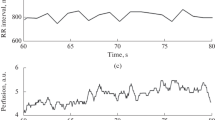Summary
Forearm blood flow was measured four times per minute by venous occlusion plethysmography during rest and during a brief emotionally stressful mental task. During emotional stress not only was the mean forearm blood flow increased, but the single blood flow values fluctuated more than at rest. The greater fluctuation, expressed statistically as the variance, was an indicator of emotional stress, at least as sensitive as the mean increase in the blood flow. Both a tranquillizer (thioridazine) and a β-blocker (toliprolol) reduced the greater variance during the emotionally stressful situation in doses insufficient to diminish the mean increase in forearm blood flow.
Similar content being viewed by others
References
Grant RT, Pearson RSB (1938) The blood circulation in the human limb; observations on the differences between the proximal and distal parts and remarks on the regulation of body temperature. Clin Sci 3: 119–139
Wilkins RW, Eichna LW (1941) Blood flow to the forearm and calf. Bull Johns Hopkins Hosp 68: 425–449
Blair DA, Glover WE, Greenfield ADM, Roddie IC (1959) Excitation of cholinergic vasodilator nerves to human skeletal muscles during emotional stress. J Physiol (London) 148: 633–647
Brod J, Fencl V, Hejl Z, Jirka J (1959) Circulatory changes underlying blood pressure elevation during acute emotional stress (mental arithmetic) in normotensive and hypertensive subjects. Clin Sci 18: 269–279
Konzett H (1975) Cardiovascular parameters and methods of measuring emotions. In Levi L (ed) Emotions — their parameters and measurement. Raven Press, New York, pp 369–378
Williams RB, Bittker TE, Buchsbaum MS, Wynne LC (1979) Cardiovascular and neurophysiologic correlates of sensory intake and rejection. I. Effect of cognitive tasks. Psychophysiology 12: 427–433
Stroop JR (1935) Studies of interferences in serial verbal reactions. J Exp Psychol 18: 643–662
Konzett H, Strieder N, Ziegler E (1968) Die Wirkung eines β-Rezeptorblockers auf emotionell bedingte Kreislaufreaktionen, insbesondere auf die Durchblutung des Unterarms. Wien Klin Wochenschr 80: 953–959
Konzett H, Berner W, Lochs H (1973) Emotionally induced cardiovascular changes in man as a means for the investigation of tranquillizing drugs. Psychopharmacologia 30: 75–82
Thiekötter J, Angermeier WF (1974) Forgetting: Length of material, motivation and memory span. Naturwissenschaften 61: 507–508
Düker H, Lienert GA (1959) Konzentrations-Leistungs-Test K-L-T. Verlag für Psychologie, Göttingen
Breier Ch, Kain H, Konzett H (1979) Personality dependent effects of the ACTH 4–10 fragment on test performances and on concomitant autonomic reactions. Psychopharmacology 65: 239–245
Barcroft H, Swan HJC (1953) Sympathetic control of human blood vessels. Edward Arnold, London
Sachs L (1978) Angewandte Statistik. 5. Aufl. Springer, Berlin Heidelberg New York
Dicker SE, Steinberg H (1957) The effect of methylpentinol in man. Br J Pharmacol Chemother 12: 479–483
Konzett H, John R (1964) Neuropharmaka vom Tranquillizer-Typ und die emotionelle Reaktion der Muskelgefäße am Menschen. Drug Res 14: 1175–1179
Glover WE, Greenfield ADM, Shanks RG (1962) The contribution made by adrenaline to the vasodilatation in the human forearm during emotional stress. J Physiol (London) 164: 422–429
Barcroft H, Brod H, Hejl Z, Hirsjärvi EA, Kitchin AH (1960) The mechanism of the vasodilatation in the forearm muscle during stress (mental arithmetic). Clin Sci 19: 577–586
Author information
Authors and Affiliations
Rights and permissions
About this article
Cite this article
Breier, C., Kain, H. & Konzett, H. The variance of forearm blood flow as an indicator of emotional stress. Eur J Clin Pharmacol 25, 535–538 (1983). https://doi.org/10.1007/BF00542124
Received:
Revised:
Accepted:
Issue Date:
DOI: https://doi.org/10.1007/BF00542124




